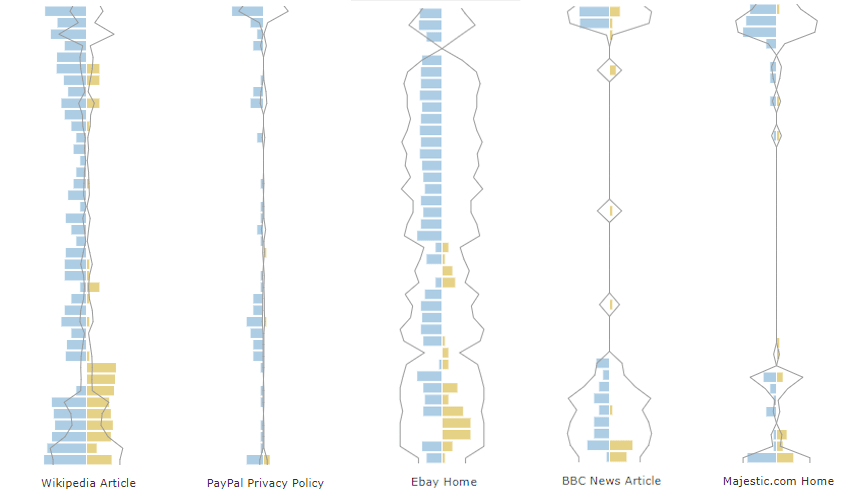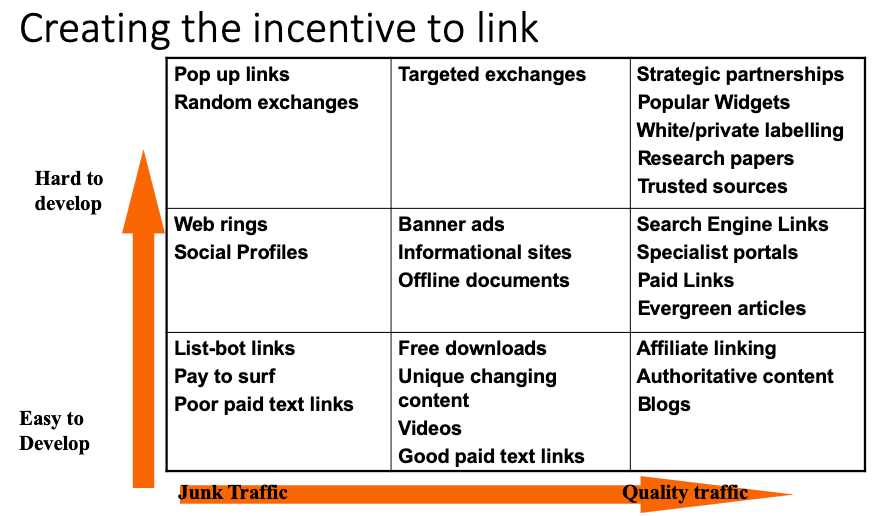Backlink Analysis
Every backlink analysis should start by considering the location of a backlink. Good backlinks are those in sentences, i.e. in the text of the main body. A second metric you should consider is the topical relevance of the backlink. Ideally, link building for SEO should produce backlinks positioned within the context of a phrase and be topically relevant, i.e. cover similar topics to those we cover with our website.
The combination of these two factors (location and topical relevance) is a dream come true for SEOs! On the other hand, a backlink sitting in the navigation or footer area of a website will have much less impact on SEO performance. Google has a patent called "reasonable surfer". In this patent, Google explains how a person might click once they land on a page. Their evaluation concludes that all links are different, and the position on a web page is essential. Therefore, Google will assign a different weight to backlinks based on where they "live" on a page.
Your backlink analysis should take into account and contextualize links on a mobile device. Google now looks at websites using a mobile-based crawler. Search engines analyse pages on a mobile phone rather than on a desktop. In general, it makes sense to check backlinks and make sure the user will see them on a mobile phone.
Backlink analysis should consider page prominence
Link building for SEO should identify pages with a prominence of their own. The fact is that search engines value the most pages with a rich and articulated backlink profile. Your backlink analysis must identify this factor.
Incoming backlinks to a page can also be backlinks coming from within the website. Internal links can also boost prominence.
Internal links can also boost prominence. Therefore, the page requires some links from the home page or the main pages on the website.
The kind of backlinks for SEO you don't want in your backlink profile
Your link building for SEO efforts will identify many, many SPAM pages of various types which densely populate the Internet. One example of a SPAM page is a page with long lists of backlinks. The search engines will index these pages. However, the strength of a backlink from such a page is divided, at best, amongst all the links present on the page. Therefore, a page is far less relevant than if there were only one or two backlinks on the page.
Backlinks need to be visible to all users
There are a few other things you need to consider in your link building for SEO. For instance, a backlink must be visible to ALL users - even when not logged onto the website. The perfect example for such a case is a link coming from Facebook. When you're on Facebook, you are a logged user. Logged users can see all the content and the links, but Google cannot access that backlink because the spiders cannot log into Facebook! So generally speaking, Facebook is usually not the best place to do link building for SEO.
rel="nofollow" backlinks
Backlinks with a NOFOLLOW attribute carry a distancing signal the search engines detect. Nofollow Backlinks indicate that the author does not give any credit or endorse the website they have linked. With a nofollow attribute, they could be stating their uncertainty about the website - they don't know whether it's good or bad.
Another way to see this attribute is to request the search engines to consider this link less like an endorsement and more like a website they are aware of but do not have a particular knowledge about it
Backlinks with and without the rel="nofollow" attribute are similar to the difference between an acquaintance and a friend. Recently, Google have introduced two modifications to the rel="nofollow" attribute:
- rel="ugc"
- rel="sponsored"
With the rel="ugc", we refer to user-generated content. This link attribute is something content management systems add to links produced by the users who, for example, leave comments or create other types of content.
Then there is rel="sponsored" which is used by search engines to avoid considering sponsored (or paid) links for organic placement. A backlink with such an attribute tells the search engines we have paid for it and therefore are utterly useless in our link building for SEO efforts.
The Internet is like a pyramid of Lego bricks

If you look at the Internet as if it were a giant pyramid and every page were a dot on the Lego bricks, you would like to have links from pages that are at the top of the pyramid. Unfortunately, such pages are few and far apart and extremely difficult to engage. At the very top of the pyramid, there is a little two by two Lego brick. At the bottom there are hundreds and hundreds of dots on the Lego bricks. In essence, there are very few pages on the Internet that are very strong, and there are many pages on the Internet, which are very weak. The higher you can get up the pyramid, the better.
The strength of a web page
The strength of the page is a complicated topic which we will discuss in more detail. Various tools can help find the strength of a page: for example, Moz or Ahrefs and Majestic are just three of the best-known link building tools for SEO. Knowing the power of a web page is very, very important. Another way of looking at this is to imagine the Internet as a cobweb.
If this is a picture of the Internet, we can imagine the pages being the nodes at the intersection of the web lines and the lines themselves as links connecting the pages. Of course the web is not as organised and clean as this beautiful cobweb! What's important to understand here, is that nodes at the edge of the web have fewer "roots" than nodes sitting at the WWW's heart. The most important pages are in a "central" position (see this paper on the bow tie theory). However, there are exceptions to this rule. Search engines consider pages from Wikipedia to be "in trust". Wikipedia pages are pages that Google understands are instrumental in keeping the web live.
Web pages fall into different categories
For link building in SEO, understanding web pages is vital in a backlink analysis. When you look at web pages for link building, they tend to fall into distinct categories, depending on the backlinks that are coming out of them.

So let's examine the visual representations of different types of web pages in the previous image. We have reviewed a Wikipedia article on the left-hand side and a page from the drudge report on the right-hand side. What we have done here is divide the page into different sections. As we go down the page, you'll notice 40 different sets of bars, and on the left-hand side there are blue lines showing internal links, and on the right-hand side there are yellow lines that show external links.
In a backlink analysis, Majestic will highlight your link on the page with a little green bar. You can immediately spot it because of the colour. The higher up your link appears on the page, the better. As you gain experience, you will notice the number of links on pages: they can be cumbersome at the top and the bottom, and that's because those sections of the page are headers or footers.
In the pages we are examining, there are many internal links in the header area with fewer external links. As we mentioned earlier in this article, it's best to have a backlink in a page's body, rather than in the navigational bar. Majestic provides metrics for you to understand the importance of a page and the topical influence it offers with a backlink. Without these metrics, it isn't straightforward to understand the importance of a page. Another factor you should monitor is the number of incoming backlinks, and Majestic provides you with that information as well.
When a backlink looks good but isn't
Here's an example of what you might think is a good backlink but isn't. Consider, for example, a link from the BBC. You'll immediately think it's a brilliant opportunity and a link that will boost your rankings. Is a link from the BBC all that great? The answer is: it depends. If they placed the backlink in the navigational bar, it's not as good as it could be if they had put it in the context of an article. Navigational links miss the link equity coming from the page itself even though it comes from a big site like the BBC.
Editorial Backlinks
Generally speaking, an editorial backlink is positioned in the context of an article. These are the most valued and challenging to earn backlinks and represent the biggest challenge for linking building in SEO. You can find numerous examples of editorial backlinks in the Majestic Blog such as this article on getting media coverage and editorial backlinks. Although most of these high-quality backlinks are nofollowed, they are well worth the effort. In fact, with the recent introduction of new link attributes, Google has stated they can follow links with a nofollow attribute at their discretion, AND we can add value them appropriately.
Create the incentive for people to give you a backlink
Getting back to the difference between a good backlink and a bad one, we could run an analysis to help us identify good links and bad links. A way to proceed is to take all the different ways in which you might be able to build links and put them in a 3x3 grid:

This matrix can help evaluate which links will create good quality traffic to your website - the kind of traffic that will result in sales or leads. You want things that are on the right-hand side of this chart. You also would like things that are going to be unique to your brand and your website. Of course, you want content that will be hard for other people to develop: your activities should include strategic partnerships, private labelling, research papers, etc. This kind of content will be hard for your competitors to copy.
About link building for SEO with paid backlinks
Not all of these different types of links can or will deliver significant benefits in the search engines if they are paid backlinks. Whether they're good or whether they're bad, it is dangerous to perform link building for SEO with paid backlinks. Quality backlinks will benefit your rankings but, as you probably know, Google terms of service warn about using paid backlinks.
Paid (or purchased) backlinks
If you're going to put paid backlinks on your website, the question is: what is a paid backlink? Is a strategic partnership a paid link? For example, Tesco probably have a large partnership with a haulage company, and that haulage company may well link to Tesco, and it may be in the interests of both parties to link to each other. The two companies are in an authentic relationship - but is that paid? It isn't straightforward to tell.
Take all the different ways you think you can create links and think about quality in terms of possible traffic they can generate. Then you have to screen the backlinks to judge whether it's going to be a backlink that will be ignored or, even worse, penalised by the search engines.
In summary
In this article, we have focused our efforts on link building for SEO and identifying good and bad backlinks. We can summarize all the concepts expressed in this article by saying that a good backlink is one placed in a sentence in the main body of a webpage.
Ideally, our link building for SEO should identify web pages with a particular affinity to ours. We can measure the affinity via our Topical Trust Flow. Mobile compatibility is essential. Our backlinks should be on pages with some prominence and link equity of their own. Thanks to our Link Graph you can assess the strength of a page and understand how other websites link to it.
Finally, the new HTML link attributes (rel="ugc", rel="sponsored") and the new interpretation of rel="nofollow" may modify the impact of a backlink.
So we trust this article has given you a good idea of what a good backlink is - please don't go and get bad ones!